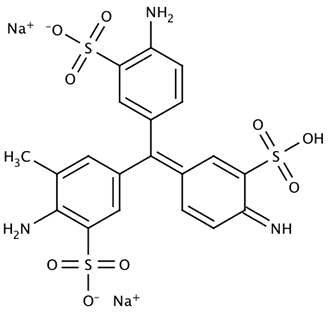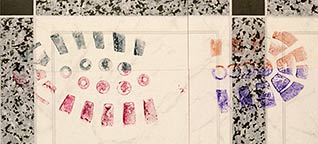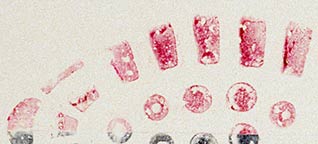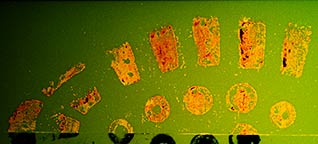How to use Hungarian Red
On what surfaces can it be used
Hungarian Red is a dye (Acid Fuchsin) solution in water/acetic acid mixture that is used for staining fingerprints and footprints made in blood. Prints in blood are colored red after treatment with Hungarian red. Hungarian Red should not be used on absorbent surfaces like paper, carton materials, bed sheets, or carpet. It works very well on non-absorbent backgrounds like linoleum, glass, tiles, painted surfaces, or PVC floor covering.
Fix prints in blood before staining
Before staining, prints in blood should be fixed to prevent them from running (causing loss of detail) when the staining solution is applied. In general fixative is applied before any staining solution except Leuco Crystal Violet, which contains fixative.
How to fix the prints
Fixing is best done with a 2% solution of sulfosalicylic acid in water (20-23 gram in 1 liter). To make sure the print in blood is thoroughly fixed, we recommended the following method using absorbent paper (like filter paper, tissue paper, or paper towels) and a wash bottle containing sulfosalicylic acid solution.
Take a dry piece of the absorbent paper that is sized to cover the print(s). Hold it directly over the print-area, parallel to the surface and just slightly above the surface. To begin fixing, drop one edge of the paper to the surface and moisten heavily along its entire length, so that it is anchored and will stay in place. Starting from that edge, wet the paper progressively further while smoothing the wetted part onto the print and minimizing trapped air bubbles. Work carefully from one edge to the other. When possible, for example, with an object or with a print on an angled surface start from the top and work downwards.
Once the wet paper entirely covers the print, leave it there for a minimum of three minutes. When the blood is a thick layer, leave the paper there 5 minutes or more. Remove the paper. An excess of fixative can be rinsed away with water, but this is not necessary.
When the blood is relatively fresh, you will notice that fixing changes its color from dark red to dark brown.
Staining procedure
Once the print is fixed, it can be stained with Hungarian Red. The most economical way is using the sprayer. Spraying always causes some mist (aerosol) that will float around in the air. Especially when you stain large areas, do use some respiration protection. Alternatively, you can use a wash bottle (or with fingerprints even a disposable pipet).
After the staining solution is applied by sprayer or wash bottle, leave it in contact with the print for about one minute. Then wash the surface with water (or a 5% water/acetic acid mixture = 19:1 volume/volume ratio). If the print is located on a floor, the wash water might be removed with a vacuum cleaner that can handle water. Otherwise, remove it with paper towels or the like.
It is advantageous to immediately remove the water and water droplets from the processed area after rinsing, with compressed air or a powerful blower. If water droplets remain on the print, you will notice that some dye will dissolve in them. After drying that will be visible (possible loss of detail).
Lifting and fluorescence
Hungarian Red not only has a good staining capacity but has also some special characteristics. Stained prints can be lifted with a white BVDA gelatin lifter so that backgrounds are eliminated and/or parts on dark backgrounds become visible. The lifted print will also fluoresce, whereby details or prints that were hardly visible with the naked eye are now easily discernible in fluorescence.
Before lifting with a white gelatin lifter, the area should be completely dry. Be very careful not to trap air bubbles under the lifter surface and leave the lifter on for 15-30 minutes. Photograph within a couple of hours after lifting (the dye will slowly diffuse in and across the surface of the lifter, thereby blurring the print).
Lifting can be done more than once, with or without re-staining between lifts. Repeat lifting/staining in important cases.
Fluorescence is excited with green light (515-560 nm) and the filter used in front of the lens is a red filter (Kodak Wratten 25, a barrier filter of about 600 nm or a long-pass filter with cut-on of about 600 nm).
Safety
Hungarian Red is not labeled as a hazardous preparation. Since it is water based, no harmful fumes are liberated in use, although the acetic acid smell might be irritating. It will color the skin, although this will not last very long (in our experience less than a day). Contaminated clothing will be stain-free after regular washing.
Sulfosalicylic acid crystals are labeled as an irritant substance, the 2% solution is not labeled as a hazardous product. Given the fixative effect on blood, we strongly advise wearing gloves (vinyl gloves will suffice) when using it.Avoid breathing aerosols (mists) of both the fixative and Hungarian Red. Likewise avoid contact with solutions and wash your hands after each session, especially before eating or drinking.
Effect on DNA analysis
According to a Canadian study useable DNA can still be retrieved from treated prints after staining with Hungarian Red.

Name: Acid Fuchsin, Acid Violet 19
CAS-No.: 3244-88-0











